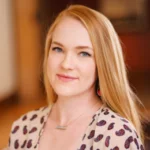By Jerilyn Forsythe, McKenzie Kupchik and Mellanie Perez
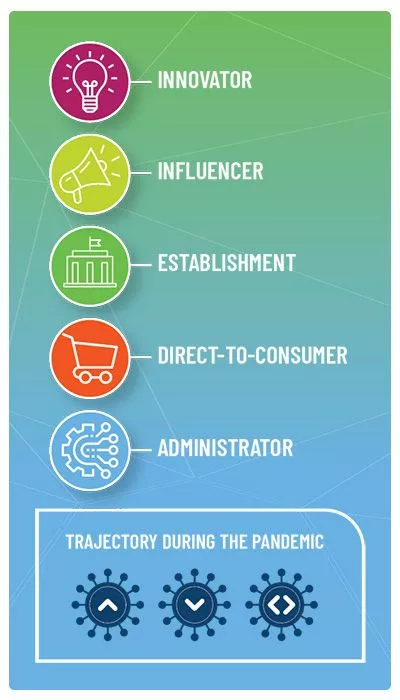 Our profession has made it through what appears (we hope) to be the worst of the pandemic with aplomb. Incisal Edge’s fifth annual ranking of dentistry’s top players—scientists, practitioners, researchers and even a celebrity or two for good measure—aims to tell the tale of how far the industry has come in the last 18 months, and where it goes from here.
Our profession has made it through what appears (we hope) to be the worst of the pandemic with aplomb. Incisal Edge’s fifth annual ranking of dentistry’s top players—scientists, practitioners, researchers and even a celebrity or two for good measure—aims to tell the tale of how far the industry has come in the last 18 months, and where it goes from here.
IT WAS A YEAR LIKE NO OTHER. In the 2020 iteration of this annual list, published early last summer, we observed with dismay that “we still have no clear idea of how best to combat Covid-19.” That, thankfully, is no longer true—the miracle of widespread vaccine access is here, and the U.S. seems almost to be fizzing with pent-up economic and social demand spurred by more than a year in some form of quarantine, lockdown and a narrower scope of life more generally.
Dentistry, all things considered, weathered the pandemic in excellent shape. The American Dental Association’s emergency coronavirus task force, whose vital work we detailed in our Spring 2021 issue, helped set sanitation standards and provided some codified rigor for anxious dentists across the country. Practitioners themselves, certainly no strangers to the virtues of sterilization and good hygiene, rolled with the (plentiful) punches, establishing new safety protocols to ensure that their patients could get back in for appointments as soon as possible. It worked. As far back as last November, the ADA was reporting that capacity at dental offices nationwide was up to 76 percent of pre-pandemic levels—before a single vaccine had been injected in a single arm. Throughout the rest of 2021, as life returns, however fitfully, to normal, that figure will go higher still.
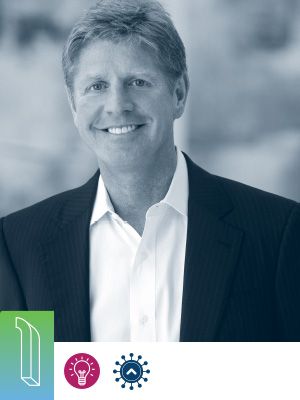 THE ALIGNMENT EMPEROR
THE ALIGNMENT EMPEROR
JOSEPH HOGAN
CEO, President, and Director, Align Technology
San Jose, California
Last year: 2
HE’S BAAAAAACK! After slipping all the way to No. 2 last year behind 3M’s Eric Wenzel—who vaulted into the top spot seemingly out of nowhere given his company’s sudden importance to the worldwide manufacture of personal protective equipment—Align Technology’s Joseph Hogan, the company’s top boss, returns to the pole position, where he debuted in 2019.
Like so many others, of course, Hogan and his company have had their ups and downs of late. In the second quarter of 2020, Align reported revenue of $352.3 million, more than 41 percent lower than the first quarter a year prior—and the forecast for the rest of 2020 looked bleak, to say the least. But the maker of the wildly popular Invisalign teeth-straightening system, under Hogan’s direction, stayed the course—a bold move that is already paying dividends.
During that same second quarter of last year, Align—which so bestrides the market that the very name “Invisalign” has become a household name in the manner of Xerox, Q-Tip and Google—closed on a deal to acquire German CAD/CAM software company Exocad Global Holdings for some $419 million. Exocad makes software for dental labs and ortho practices through its 200 partners and resellers in 150 countries. The acquisition, which brings Exocad’s expertise in restorative dentistry, implantology, guided surgery and smile design into Align’s portfolio, was intended, Hogan told investors last year, “to pave the way for cross-disciplinary dentistry.” He added, “We’ll extend Exocad’s position as a key technology provider for the dental CAD/CAM industry and drive continuous innovation with the open and integrated approach that is the foundation of the company.”
It’s a financial truism that balance and diversification will help you weather a crisis. Align is proof of the wisdom of that old chestnut: Its Q4 2020 revenue was $834.5 million, up 28.4 percent year over year. Its clear aligners alone made up $700.7 million of that. The fourth quarter also showed increased Invisalign adoption by both teens and young adults, up nearly 40 percent year over year in each case—thanks perhaps to a successful advertising campaign carried out with the help of social-media influencers Charli D’Amelio, Christina Milan, Rachel Zoe, Tahj Mowry and others. “They continue to deliver exciting new content and increased engagement for the Invisalign brand with consumers and among their millions of followers,” Hogan exults.
t all added up to a 138 percent share-price increase in the 12 months prior to press time—and a market capitalization of $47 billion, far higher than any public dental company has ever achieved. “Twenty-twenty was a year unlike any other that we’ve experienced,” Hogan told investors early this year. “Despite the swift onset of the pandemic and uncertainty throughout, we completed the acquisition of Exocad, accelerated investments in marketing to create Invisalign brand awareness and drive consumer demand to our doctors’ offices, accelerated new technology to market with virtual tools that enabled our doctors to stay connected with their patients…. As a result of our continued strategic focus and investments, we exited the year stronger than we started, and 2021 is off to a great start.” The stars, you might say, are aligning.
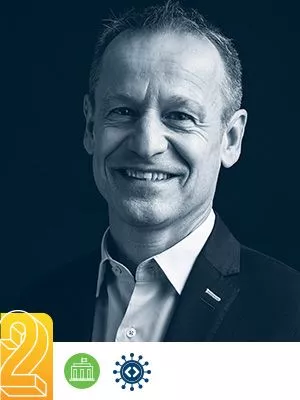 THE GLOBAL IMPLANT KING
THE GLOBAL IMPLANT KING
GUILLAUME DANIELLOT
CEO, Straumann
Basel, Switzerland
Last year: 25
WITH A MARKET CAPITALIZATION north of $21 billion as of press time and 7,700 employees worldwide, Straumann remains top dog in the highly competitive estimated $4.3 billion global market for dental implants. When Guillaume Daniellot was named CEO of the Basel, Switzerland–based company in January 2020, replacing longtime luminary Marco Gadola, the Frenchman was in his thirteenth year with Straumann and the nineteenth of his dental career. His expertise would be sorely tested.
Although overall demand for implants decreased by roughly 10 to 15 percent in 2020, most of Straumann’s revenue dip due to the pandemic was concentrated in the first half of the year; overall, its organic revenue in 2020 went down by only 6 percent, to $1.5 billion. Daniellot is bullish in the near term, though, having set for Straumann the goal to reach annual revenue of about $5.5 billion over the next five to eight years. (Investors remain favorably disposed as well; Straumann’s stock notched an 8 percent gain in 2020 and was up another 19 percent as of late April.)
It appears that the 51-year-old, in addition to preserving and building on Straumann’s status as the world’s biggest implant manufacturer, also wants to increase its footprint—and take on (or take down) the market leader, Align Technology (see Joseph Hogan, No. 1)—in the fast-growing $4.8 billion market for clear aligners. The company first ventured into aligners with its $150 million purchase in 2017 of ClearCorrect, a Texas-based global manufacturer of invisible braces.
“In order to reach our sales target, we must broaden our field of activity,” Daniellot told the Swiss newspaper Neue Zürcher Zeitung in November. He has done so with—among other initiatives—the July 2020 acquisition of DrSmile, a Berlin-based provider of direct-to-consumer (but doctor-led) clear aligner treatments. It also recently debuted ClearQuartz, a “triple-layer high-performance clear aligner material.” Straumann’s ambitions are legion. It’s Daniellot’s remit to see them to fruition.
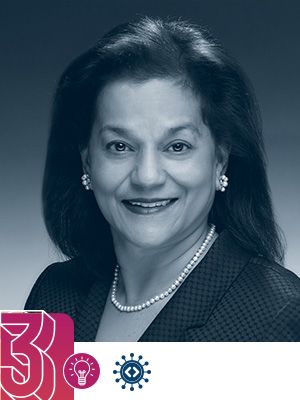 THE NIDCR’S NEW BOSS
THE NIDCR’S NEW BOSS
RENA D’SOUZA
Director, National Institute of Dental
and Craniofacial Research
Washington, D.C.
NEW
THE PREVIOUS HEAD of the National Institute of Dental and Craniofacial Research was Dr. Martha Somerman, a research Goliath of the first order (and a mainstay of the first three iterations of this list) who had led the NIDCR since August 2011. She passed her baton to Dr. Rena D’Souza in August 2020, when Francis S. Collins, director of the National Institutes of Health, appointed her its ninth non-acting director. Dr. D’Souza, 66, is now in charge of the NIDCR’s $434.6 million budget. That figure, for fiscal 2021, actually marks a nearly 10 percent funding decline from a year earlier—in recent times the NIDCR’s budget has typically been closer to $475 million—but is still by a wide margin the largest amount of money, public or private, being spent on oral-health research. Among the agency’s targets: oral cancer, orofacial pain, tooth decay, periodontal disease, craniofacial development disorders and the oral complications of systemic disease.
Having graduated from her hometown University of Bombay, India (now known as the University of Mumbai), with a bachelor’s in dental surgery and a general-practice residency, Dr. D’Souza moved to the U.S. in 1978 and earned her DDS, MS and Ph.D. at the University of Texas Health Science Center in Houston. Prior to her NIDCR appointment, Dr. D’Souza was assistant vice president for academic affairs and health sciences at the University of Utah, for whose dental school, founded in 2012, she served as inaugural dean. (She was also a professor of neurobiology and pathology there.) She has been president of the International Association of Dental Research and the American Association for Dental Research. She’ll now be directing research from a national stage, and former colleagues—Dr. D’Souza declined an interview request for this feature—call her an ideal choice, having “worked tirelessly to attain funding for dental education’s research agenda throughout her career,” says Dr. Karen West, president and CEO of the American Dental Education Association, who has known her for many years.
Dr. D’Souza’s immediate response to the pandemic upon assuming control of the agency was to allocate roughly $4 million in supplemental support to the study of Covid-19. Meanwhile, the NIH’s Rapid Acceleration of Diagnostics–Radical initiative—“RADx-Rad”—funded six grants to address Covid-19 testing and surveillance, including contact tracing of infected people and estimating the likelihood of viral spread during certain procedures versus others. One $1.3 million grant, given to the University of California, San Diego, is being used to develop a sensor, usable with a standard face mask, that detects the proteases specific to the virus both when a user breathes into it and in the air the mask encounters. “We’re repurposing something people are already wearing to monitor the environment,” says Dr. Jesse Jokerst, the nanoengineering professor leading the UCSD project. The sensors are set to debut later this year.
Dr. D’Souza has worked tirelessly to attain funding for dental education’s research agenda throughout her career.
Likewise, Aerosol Devices Inc., a Colorado-based supplier of scientific equipment, is putting its $135,000 grant to work developing a bioaerosol collector that captures nearly 100 percent of infectious particles by identifying them in exhalations. Called the SARS-CoV-2 Breathalyzer for Direct Virus Detection, it will also have a smartphone component, connecting test results to central databases for real-time, up-to-date infection information—yet another device with significant practical application even after the worst of the pandemic is in the rear-view mirror.
In addition to the half-dozen RADx-Rad grants, the NIDCR has funded 20 supplemental Covid-19 research projects ranging from the development of a droplet- and aerosol-generating respiratory-patient simulator (complete with a signature typodont) to sensors placed on dental professionals and throughout their workspaces that measure aerosol particle size, quantity and composition.
Looking ahead, one factor to keep an eye on is what happens to the NIDCR’s budget in the next round of Congressional appropriations with House Democrats in charge. What are we getting for our $450 million, give or take, in public financing every year? The NIDCR’s history includes early fluoridated-water studies and pioneering research in biochemistry, cleft palate, microbiology and immunology, anesthesia safety, implant therapy and much more. The newest general leading the charge will be Dr. D’Souza, the research star thrust by fate into a position of enormous importance for public health nationwide. Dr. Somerman is no doubt proud of her successor. The rest of us, eyeballing millions of dollars in critical oral-health and coronavirus research, can simply hope for
(and expect) more in the years ahead.
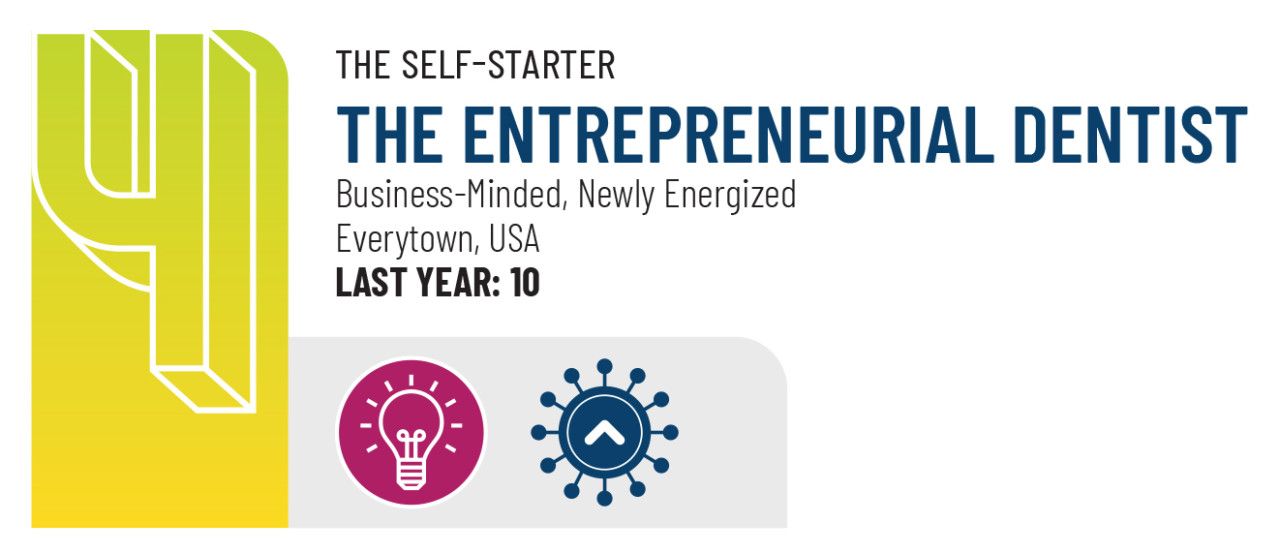 THE SELF-STARTER | THE ENTREPRENEURIAL DENTIST
THE SELF-STARTER | THE ENTREPRENEURIAL DENTIST
Business-Minded, Newly Energized
Everytown, USA
Last year: 10
TIME WAS, AN ASPIRING dentist’s typical career move out of dental school would be to start work as an associate in a private or corporate practice, or partner with another dentist. The model worked, of course, but it was a bit narrower, perhaps, than the scope of an especially independent-minded dentist’s talents. The best recent estimates are that there are some 1,000 entrepreneurial practices across the U.S., accounting for about $6 billion worth of dental care, or 6 percent of the total market. Together these practices are far larger than even the biggest DSO—in 2017, by way of comparison, Heartland Dental (see Rick Workman, No. 16), a preeminent DSO, reported that it supports dentists with an aggregate $1.3 billion in revenue.
The industry was changing long before anyone had ever heard of Covid-19, but the pandemic has created fresh opportunity for doctors to purchase their first practice, given the virus’s impact on soon-to-retire industry veterans. Data from the ADA’s Health Policy Institute (see Marko Vujicic, No. 7) indicate that 40 percent of dentists 65 and older—they number around 33,000 nationwide—plan to sell or retire this year or next if they see patient volume remain below what it was before dentistry ground to a halt in early 2020.
In addition, the annual graduate survey from the American Dental Education Association found that 65 percent of the class of 2020 changed their career plans due to the pandemic and now intend to enter private practice.
Dr. Yooson Kim, of Family Dentistry in Morgantown, Pennsylvania, is an avatar of this booming trend. She has owned practices for 20 years; she now has four in all and is looking to open a fifth. “We’re expanding and growing both horizontally and vertically,” she says. “My mothership [the original Morgantown practice] is growing not just by building multiple locations, but incorporating new technology: Solea, 3D printing, crown-milling dentistry and expanding services.”
Dr. Kim owes her success, she says, to building patient trust and staying ahead of the technological curve. When the pandemic first broke out, she was the proverbial business owner who had built a sturdy brick edifice capable of withstanding the storm. Her patient log, after an initial dip, is now back where it was before Covid-19. “When you have a business and a brand, you have to have that reputation,” she says. “When you’re an entrepreneur, understanding your organizational structure, having people in the right seats and being able to delegate is super-important.”
The entrepreneurial road is wide open for those dentists who discover a talent for the business side of practice ownership and who are willing to take on the added risk of buying or opening multiple locations. Given the number of dentists retiring, and factoring in dentistry’s continued steady growth, the future for these dentist/CEOs is bright indeed.
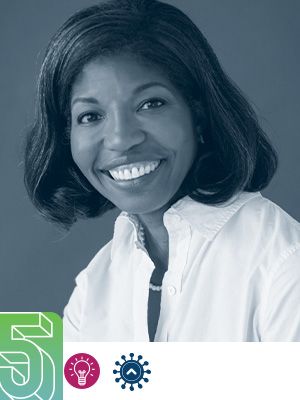 THE TOP DOC AT WALMART
THE TOP DOC AT WALMART
CHERYL PEGUS
Executive Vice President of
Health & Wellness, Walmart
Portland, Oregon
NEW
THE ENDLESS TUMULT of 2020 affected businesses large and small nationwide, but the behemoths—Amazon most notably—made it through the storm with, if anything, a more substantial economic footprint than before.
That’s also true of Walmart, the big-box colossus that retained its No. 1 spot on the Fortune 100 list for 2020, with total revenue surpassing $559 billion and a year-over-year 54 percent increase in online sales, to $24.1 billion, as many consumers avoided physical stores. Walmart was late to the online game, but its economies of scale have made it the second-largest e-commerce company in the U.S., behind only Jeff Bezos’s 800-pound Prime gorilla.
The Bentonville, Arkansas, retail giant was also Fortune’s No. 1 in 2019, a year in which its Health & Wellness division—which operates 4,700 pharmacies and 3,400 optical centers nationwide—opened a first-of-its-kind health center in tiny Dallas, Georgia, just a few months before the first confirmed case of Covid-19 on U.S. soil. The stand-alone clinic was a prototype for an ambitious corporate venture into health care: facilities offering primary and urgent care; X-ray, lab and diagnostic capabilities; counseling; and dental, optical and hearing services. The company projects it will open another 4,000 such centers by 2029, though it missed its 2020 goal of several hundred new ones.
That’s where Dr. Cheryl Pegus comes in. The cardiologist, who also has a master’s in public health from Columbia University, was hired to run Health & Wellness in late 2020. She most recently served as senior vice president and chief medical officer of the Portland, Oregon–based nonprofit Cambia Health Solutions. Previously she was the first chief medical officer at Walgreens, as well as medical director of the Cardiovascular Risk Factors Group at Pfizer.
The pandemic-spurred slowdown in opening Walmart Health Centers does not mean the initiative under Dr. Pegus is dormant. It has opened 20 such centers across Arkansas, Florida, Georgia and Illinois, with expansion plans afoot as the economy reopens. Their potential geographic reach will help close gaps in access to dental and other medical services—basic exams, fillings, crowns, teeth whitening, extractions and more—for the rural and underserved communities Walmart has catered to for decades. “We now understand the importance of health literacy, of cultural concordance and the way we speak with individuals,” Dr. Pegus told Dr. John Whyte during a WebMD video interview in February. “We’re investing in what that should look like.”
Broadening access is important to Dr. Pegus, a recent board chair of the Association of Black Cardiologists, current board member of the American Heart Association and founder of A New Beat, a nonprofit that works to improve health outcomes for women and minorities affected by heart disease. “Now that we’re opening health clinics, I can also see a physician [at Walmart],” she told Dr. Whyte. “You have one place where you’re receiving all these services by people from your community.”
Last year, Dr. Roshan Parikh was No. 7 on this list as Walmart Health & Wellness’s inaugural head of dentistry. Dr. Parikh, who helped create the Health Centers template, left his post for undisclosed reasons this March. The company has not designated anyone as its head of dental, so Health & Wellness is fully Dr. Pegus’s show now. It appears to be in a very safe pair of hands.
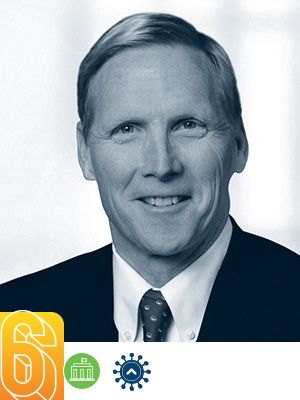 THE MARRIAGE COUNSELOR
THE MARRIAGE COUNSELOR
DON CASEY
CEO, Dentsply Sirona
Dublin, Ohio
Last year: 6
CASEY AT THE BAT: This dental heavy hitter has had his work cut out for him since he took the reins of Dentsply Sirona in 2018. Previously two distinct (and prominent) companies, Dentsply and Sirona Dental Systems were fused in 2016 under the guidance of former CEO Jeffrey Slovin—who earned the No. 1 spot on our inaugural 32 Most Influential list the following year—in what was billed at the time as a “merger of equals.”
Equals they might have been, but the hookup was initially anything but smooth, resulting in the defenestration of Slovin and several other top executives not too long after. A few years into the job, Casey, 60—who previously headed health-care services company Cardinal Health—has successfully guided the merged duo through the early integration troubles and seen its stock more than double since its pandemic low, reviving to near its five-year high. Having smartly recovered from its first-quarter coronavirus woes, its fourth-quarter 2020 net sales were $1.1 billion—almost exactly comparable with its quarterly performance a year earlier.
“Our fourth-quarter results reflect the continued focus on disciplined execution and the gradual recovery in global dental markets,” Casey told investors early this year. “Our team delivered strong operational performance, exceeding our expectations across most metrics.”
It’s worth noting, too, that Dentsply Sirona capped off 2020 by acquiring Byte (the $1 billion all-cash deal closed on New Year’s Eve), a growing direct-to-consumer company in the clear-aligners market and a competitor of Smile Direct Club. In doing so, it’s making evident its ambitions to surmount the market leader, Align Technology (see Joseph Hogan, No. 1). This January, it also acquired Datum Dental for $95 million, bringing under its umbrella the Israeli company known for its regeneration products, with which Dentsply Sirona had a previous U.S. distribution agreement. The pickup added Datum’s proprietary implant tools and biomaterials to Casey’s quiver, giving Dentsply Sirona a vast portfolio rivaled only, perhaps, by that of Straumann (see Guillaume Daniellot, No. 2).
“This acquisition is key to accelerating our growth in the clear-aligner space,” Casey told investors after the Byte deal closed. “While uncertainty remains on the timing and extent of a full recovery in the dental market, our 2021 outlook reflects our confidence in our portfolio and our commitment to driving growth through strategic investments.”
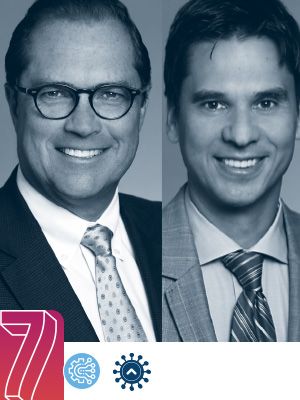 THE ADA’S A-TEAM
THE ADA’S A-TEAM
MICHAEL GRAHAM
Senior Vice President, Government and
Public Affairs, the American Dental Association
Washington, D.C.
Last year: 9
MARKO VUJICIC
Chief Economist and Vice President,
ADA Health Policy Institute
Chicago, Illinois
Last year: 9
THE AMERICAN DENTAL ASSOCIATION, an industry bellwether for more than 160 years, stepped into a vastly more complex role last year as the pandemic disrupted the lives of patients and practitioners in ways both minute and monumental.
The flood of assistance for dentists started, in many respects, on Capitol Hill. Industry über-lobbyist Michael Graham, a regular on this list since its inception five years ago, helped lobby Congress for what became five Covid-19 relief packages, as well as the first-tranche $349 billion Paycheck Protection Program. The latter provision was dentists’ most popular form of financial assistance—but, again thanks in part to Graham, it wasn’t the only option: The ADA also ensured that dentists were eligible for Economic Injury Disaster Loans, which provided grants up to $10,000 for businesses with fewer than 300 employees. According to data from the ADA’s Health Policy Institute (HPI), more than 90 percent of dentists applied for some form of financial relief in 2020.
The man at the helm of the HPI is Marko Vujicic, who is making his fourth consecutive appearance on this list. Very early in the pandemic, the HPI began to monitor the on-the-ground industry effects of Covid-19, finding among much else that an astonishing 97 percent of dental practices closed in March 2020, and the numbers it crunches are a vital resource for policymakers at both the federal and state level.
Graham’s lobbying, backed by Vujicic’s research, helped the ADA work closely with the Federal Emergency Management Agency as well, ensuring that dentists would gain access to scarce personal protective equipment in the pandemic’s early months.
A note, too, about Dr. Kathleen O’Loughlin, the outgoing executive director of the ADA. We’ve removed her from formal recognition here—she appeared on the first four iterations of the 32 Most Influential, always in tandem with Graham and recently with Vujicic as well—solely because she announced her retirement last year. She remains busy in the meantime, though, helping hone the particulars of Common Ground 2025, the association’s plan for the next half-decade. The ADA has until the end of 2021 to find a replacement for Dr. O’Loughlin, the first woman to serve as its executive director. Its choice of a new chief will indicate the ADA’s priorities looking ahead—and will be one of the most consequential industry decisions of the year.
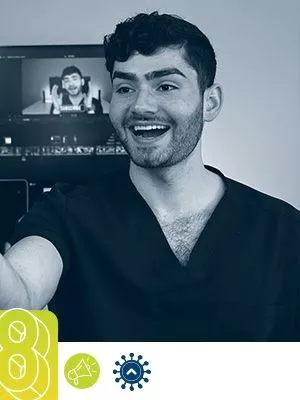 THE MODERN MEDIA MOGUL
THE MODERN MEDIA MOGUL
ANTHONY BAROUD
Influencer
Chicago, Illinois
NEW
WANT A SENSE of how much the power of social media is upending just about every industry imaginable? Consider the fact that one of the most newly influential people in our profession is Anthony Baroud, a 23-year-old dental student at the University of Illinois at Chicago College of Dentistry. He’s very much an Anthony-come-lately, too: He didn’t start his TikTok and YouTube accounts (@DentalDigest) until late 2020—but just six months in, he has more than 1.5 million followers and 82 million views on YouTube, and (you might want to recline in your dental chair for this one) nearly 7.5 million followers and a breathtaking 154 million likes on TikTok.
That puts him high in the social media firmament. He’s no Katy Perry (109.5 million Twitter followers), but he leaves, say, Matt Damon (56,500 Instagram followers) not liking them apples very much at all. Who knew dentistry could be such a crowd-pleaser? Baroud, for one. His timing was good, as he set out to capitalize on people’s vast increase in screen time during the pandemic. But his determination to make his mark was less than spontaneous. Since middle school, Baroud has been interested in online content creation; when he got to dental school, he spent several months brainstorming what exactly he wanted to produce. He settled on “high-quality, informative dental content,” he says, and within just a month of his TikTok debut, @DentalDigest had surpassed 1 million followers.
“Depending on what’s going on with school,” he says, he spends between 15 and 50 hours a week shooting and editing videos and managing his online presence. The lucrative side hustle is paying off in the form of per-view ad revenue, sponsored campaigns for a variety of dental products and affiliate links. “Everyone knows how expensive dental school is,” says Baroud, who is on track to graduate from UI Chicago in 2023. “I am far from being able to pay it all off at the moment, but it is my goal to graduate debt-free.”
He then hopes to maintain his presence (and his influence) as he builds his career. “As I continue through my education and transition into a dental practice, my content is going to evolve into a more in-depth and engaging dental experience for viewers,” he says. “My plan after graduating is to find a general-dentistry office that encourages me to refine my craft and challenges me on new levels ranging from dentistry to business management.”
His entrepreneurial spirit ought to serve him well. “I foresee the future of dentistry as groundbreaking, and I want to be a part of that evolution,” he says. He hopes to launch his own line of dental products later this year. He won’t divulge any details just yet, but keep your eyes on the various @DentalDigest accounts for hints of what’s to come. “This,” he says, “is only the beginning.”
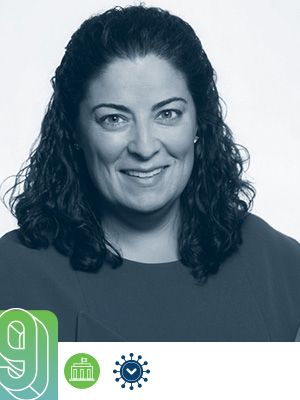 THE P&G LIFER
THE P&G LIFER
KELLY HEAPS
Vice President, Professional Oral Health,
Procter & Gamble
Cincinnati, Ohio
NEW
INNOVATIVE THINKING and the ability to observe, adapt and change are the skills that can ensure a business’s survival in times of crisis—and in such perilous moments, it’s especially beneficial if the person in charge knows the contours of the company inside and out.
That’s certainly the case with Kelly Heaps, 43, vice president of Crest and Oral-B’s Professional Division. She’s a professional lifer at Procter & Gamble, the immense conglomerate under which those two dental megabrands operate. A graduate of Dartmouth (her degree is in psychological and brain sciences) who also has a marketing MBA from Boston College, she began working for P&G in 2000—as a brand assistant for Gillette in Boston, when it was a stand-alone company—and has been climbing the ladder ever since, occupying a succession of positions in personal care before moving fully into oral health in 2006 when P&G acquired Gillette.
She drew on every ounce of that experience last spring to keep her team focused on delivering for its clientele when the pandemic truly started to bite. “The dental industry was shutting down,” Heaps says. Her first step was to address the mental and physical well-being of her more than 100 staffers. She then asked, “What can we do now? How do we support the dental industry in this time of massive disruption?” P&G inquired, and dental professionals replied with a resounding request for additional continuing education—and oh, by the way, can it perhaps be available free online?
How do we support the industry in this time of disruption?
By last May, Crest and Oral-B had provided dentists with more than 20 hours of live, virtual CE courses at no charge. That month alone, 150,000 people participated in the courses, whose topics ranged from the relentlessly scientific (“End to End: GI Tract Pathologies and Their Oral Manifestations”) and the practical/political (“Addressing Socioeconomic Disparities in Dentistry”).
Heaps also drew on her lengthy P&G tenure to partner with industry experts including renowned oral pathologist Sherri Lukes, mobile-geriatric-dentistry leader Sonya Dunbar and dental-pharmacology specialist Tom Viola to offer education on issues highly relevant to the perplexing moment. In addition to the gratis CE, meanwhile, Heaps and P&G donated more than
1 million tubes of Crest toothpaste to dentists nationwide; Crest and Oral-B also jointly contributed $250,000 to a variety of dental schools.
Her next big hurdle: getting patients back into the chair. “We know consumers have a heightened focus on their personal health right now,” she says. “They’re more open to new habits that can help them achieve better oral health. That’s where we’re focused.”
The skills she picked up via her MBA and subsequent two decades of P&G experience have enabled her to move beyond brand management into sales and operations as well, and she remains “tightly linked” to P&G’s consumer business—making her every bit as well-placed to exert influence on post-pandemic dentistry through the power of the colossal conglomerate as she has been while helping guide it through the last 18 months of grievous uncertainty.
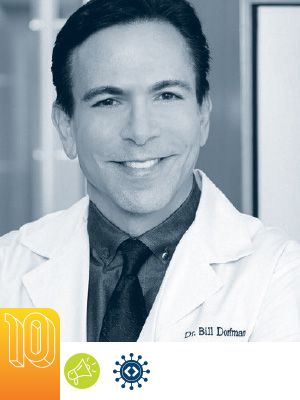 THE MULTIMEDIA MULTIHYPHENATE
THE MULTIMEDIA MULTIHYPHENATE
BILL DORFMAN
Influencer, Television Personality
Los Angeles, California
NEW
WERE WE TO LIST all of Dr. Bill Dorfman’s TV appearances, lifetime-achievement awards and encounters with the famous, we’d have no room left to talk about, well, veneers and recontouring. But that’s apropos for the man who’s known as the O.G. celebrity dentist. He was the first dentist to garner more than 1 million Instagram followers, and no less a luminary (and echt Angeleno celebrity) than the late impresario Larry King even dubbed him “the Michael Jordan of dentistry.”
Dr. Dorfman, 62, didn’t stumble into the spotlight unawares. After graduating from the UCLA (where he won the Outstanding Senior Award his final year), he received his dental degree from the University of the Pacific in San Francisco (where he was one of the youngest graduates ever to receive his doctorate degree). From there he set out to become the best cosmetic dentist he could be. Early on, he shadowed five of the most successful cosmetic dentists in the Los Angeles area, gleaning all he could—chairside manner, operatory procedures, payment and checkout particulars—and later implementing it at his own practice, Century City Aesthetic Dentistry, which he opened in 1985. Eight years later, he founded Discus Dental, a manufacturer of impression materials, restorative composites, fluorides and practice-management software. (It was sold to Philips Electronics in late 2010.)
Sometime in the 1990s—he can’t recall the exact date—a friend in public relations who was looking to get some cosmetic work done asked to barter dental services in exchange for a few write-ups in local media. A toe-dip in the Tinseltown publicity pool was all it took to convert Dr. Dorfman. “When I realized what PR could do for me, I didn’t just do it,” he says. “I did it with gusto.”
Dr. Dorfman found the limelight to his liking. He was asked to be the smile guy on Extreme Makeover, a reality television show that premiered on ABC in late 2003. “It gave me the opportunity to eliminate a lot of people’s fears around dentistry and to show all the possibilities [of] cosmetic dentistry,” he says. “People realized that without a dental makeover, there was no makeover.” The show ended in 2007, but Dr. Dorfman’s public profile has only grown: In addition to appearances on the Today show, Oprah, The View and an ongoing residency on CBS’s Emmy-winning talk show The Doctors, he’s also the holder of two Guinness World Records. Ready? “Most Valuable Grill,” for the $1 million spangled choppers he created for Katy Perry’s “Dark Horse” music video, and “Most Money Raised for a Charity Through Head Shaving by an Individual.” He was shorn live on The Doctors, raising $120,000 for the LEAP Foundation, a youth-leadership nonprofit he founded in 2008.
He’s also the creator of Smiles for Life, a campaign that has raised more than $45 million for children’s charities. He now spends half his time at his practice and the other half on TV and philanthropy, especially LEAP, whose annual weeklong leadership program has attracted A-list speakers including Anthony Hopkins and Eva Longoria. “The program teaches [young people]
not to wait for opportunities but to make them,” the doctor says. “If I had sat back and waited for something to happen, I wouldn’t be where I am today.”
THE SSC’S NEW VANGUARD
 WAEL GARINE
WAEL GARINE
Founder, Garine Prosthodontics
West Palm Beach, Florida
NEW
PARAG KACHALIA
Cofounder, Innovative Dental Concepts
San Ramon, California
NEW
AMANDA SEAY
Founder, Dr. Amanda Seay Dentistry
Mount Pleasant, South Carolina
NEW
THE SEATTLE STUDY CLUB, founded by Dr. Michael Cohen nearly 30 years
ago, has long been the preeminent continuing-education organization for dentists. Rather than focusing on standard lectern-and-auditorium-style teaching, Dr. Cohen instead created a club in which dentists come together in small groups to interact and learn from one another, and listen to presentations by globally renowned clinical speakers. SSC has grown to
more than 7,400 members in some 260 clubs worldwide.
During last year’s winter symposium, held virtually for the first time and featuring an array of dental talent from around the globe, Dr. Cohen transitioned the club’s clinical leadership to Drs. Wael Garine, Parag Kachalia and Amanda Seay. “Bringing more leaders in will strengthen the Study Club network, and that fuels our growth,” Dr. Cohen says. Dr. Garine will serve as the primary contact for all SSC directors and be in charge of increasing membership by bringing new clubs into the network. Dr. Kachalia will be involved in content development for educational resources and events, and Dr. Seay will take over as SSC’s director for outreach and engagement, focusing on developing and implementing plans to build the club’s relationships with dentists worldwide. (To that end, the trio will also work to help
SSC expand internationally.)
“With Amanda, Parag and Wael joining me in the leadership of SSC, our members can look forward to expanded educational offerings, new events and a renewed commitment to the growth of our global membership,” Dr. Cohen said when he appointed them. It’s a big job—doctors of all stripes are surely craving personal interaction after a year on the pandemic sidelines, and this talented triumvirate will work to take Dr. Cohen’s beloved brainchild to the next step in its multi-decade development. May dentists everywhere be the beneficiaries.
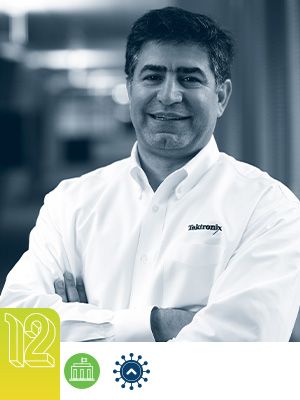 THE ENVISTA VISIONARY
THE ENVISTA VISIONARY
AMIR AGHDAEI
CEO, Envista Holdings
Brea, California
Last year: 15
NOW 62 YEARS OLD, Amir Aghdaei has been a regular fixture on this list since its inception a half-decade ago, and his responsibilities at Envista remain largely the same since he took the reins at the publicly traded company spun off from Danaher, whose dental division he ran from 2015 to 2019. (He has also been an executive at HP.)
Envista’s business has been boffo despite (all together now) the ravages of the pandemic. Its diverse breadth of products and technologies no doubt helped—it’s a 12,500-employee firm that makes more than 30 dental brands, including KaVo Kerr and Nobel Biocare, and its market capitalization as of early May was just a touch under $7 billion.
Since taking the helm, Aghdaei has continually recruited new staff and built a solid leadership team. In 2019, Envista introduced a new intraoral scanner, the KaVo Kerr X500, and has since rolled out Spark, its soldier in the clear-aligner wars, as well as DTX workplace software to help dentists manage patient images across multiple platforms.
Covid-19 was, of course, a major challenge, but Envista finished 2020 strong, logging fourth-quarter sales of $732.3 million, a 1.6 percent boost over the same period a year earlier. “We’re proud of our team’s dedication to building a company that provides customers and partners with the products and support they need to improve the productivity and predictability of care for their patients,” Aghdaei said at the time. Investors have signaled their approval; Envista’s stock is up 73 percent in the last 12 months despite the coronavirus’s buffeting headwinds. One particular growth area, Aghdaei notes: the company’s specialty and infection-prevention segments. With the pandemic receding at last, if not yet fully gone, this dental-industry fixture says Envista is now “positioned well for enhanced performance.”
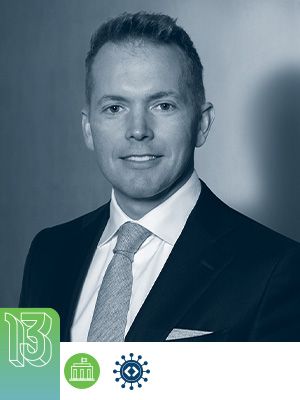 THE SWISS MASTER
THE SWISS MASTER
DIEGO GABATHULER
CEO, Ivoclar Vivadent
Schaan, Liechtenstein
Last year: Honorable Mention
THERE ARE CERTAINLY less-scenic places to ply one’s trade than the tiny principality of Liechtenstein, jammed hard between Switzerland and Austria in the Swiss Alps.
In July 2019, Swiss native Diego Gabathuler took the helm of Ivoclar Vivadent, a family-owned manufacturer of restorative and prosthetic dental products whose IPS e.max System is the world’s best-selling glass ceramic, used over the years in an estimated 100 million dental restorations.
The company Gabathuler leads has roughly 3,600 employees, subsidiaries in 30 countries and annual sales of around $800 million. It’s the largest and most valuable privately held dental company in the world; Forbes puts the net worth of former chairman Christoph Zeller—whose grandfather purchased the 25-year-old maker of artificial teeth in 1948—at $5.6 billion.
One quirk of Gabathuler’s leadership is his Jeff Bezos–like customer-service fixation. That’s no accident: Although Gabathuler began his Ivoclar career in 2002, he stepped away and headed to Silicon Valley, holding positions at Logitech, Activision and Electronic Arts before rejoining the dental mothership in 2016. “For me,” he told consumer expert Julia Ahlfeldt in January 2020 on her podcast, Decoding the Customer, “CEO means ‘customer experience officer.’ The brand … is the sum of all customer experiences.”
His time in the belly of the silicon beast also gave him reverence for technology. Ivoclar remains highly competitive in beginning-to-end restorative workflow, and in early 2020 it debuted, in conjunction with 3Shape, an integrated, open-workflow digital chairside CAD/CAM system in the U.S. “We’re striving to offer sustainable solutions for [dentists’] workflows,” an Ivoclar spokesperson tells Incisal Edge. “We learned from our customers that our job is covering both the arts and craftsmanship as well as the digital and technology-driven approach.” Spoken, in Gabathuler’s manner, like a tech true believer.
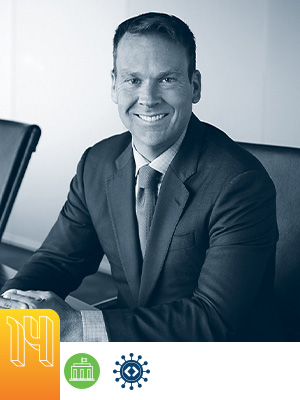 THE MAN WITH THE (INSURANCE) PLAN
THE MAN WITH THE (INSURANCE) PLAN
JAMES “WELLS” HUTCHISON
President and CEO, Delta Dental Plans Association
Oak Brook, Illinois
NEW
DELTA DENTAL IS the nation’s largest provider of dental insurance, covering more than 80 million Americans and offering the country’s largest network, comprising about 156,000 participating dentists. Delta Dental Plans Association (DDPA) is the not-for-profit national association of the 39 independent Delta Dental companies. In December, James Hutchison—known as “Wells”—took the helm of DDPA from Steven R. Olson, who had been president and CEO of the organization for eight years.
Hutchison has spent an early portion of his career at the law firm Katten Muchin Rosenman, where he served as outside counsel for the DDPA. Since he left there, he has been in the Delta Dental system for 15 years. He’ll have his plate full as the industry works to recover fully from the difficulties of the pandemic—in addition to the customary challenges of working to expand access to dental insurance nationwide.
In 2019, Delta companies provided about $76 million in direct and community-outreach support to improve the oral health of adults and children across the country; its Covid-19 relief efforts have been an order of magnitude greater, expected to top $1.1 billion in pursuit of assistance for dentists, health-care centers and patients alike. That figure doesn’t include the efforts the Delta umbrella organization made toward helping practitioners access Paycheck Protection funds and other bridge loans.
This March, to commemorate World Oral Health Day, Delta Dental released some intriguing survey findings, which indicated that 93 percent of Americans say they intend to visit the dentist in 2021. “We’re optimistic this will contribute to a positive shift toward improved overall health across the country,” Hutchison said at the time. And Delta Dental will be there to help maximize access for those who need the assistance.
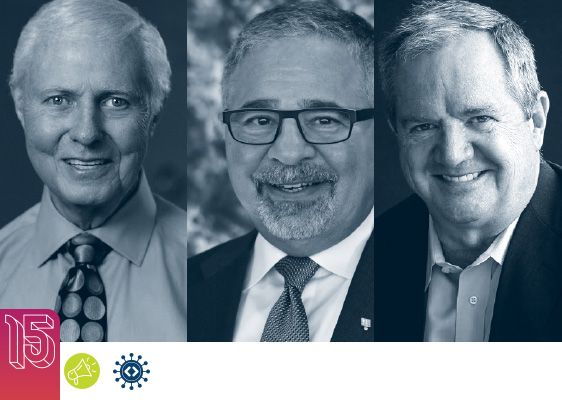 THE KEY EDUCATION AND OPINION LEADERS
THE KEY EDUCATION AND OPINION LEADERS
GORDON CHRISTENSEN
Founder and CEO, Practical Clinical Courses
Provo, Utah
Last year: 16 (tie)
JOHN KOIS
Founder and Director, the Kois Center
Seattle, Washington
Last year: 16 (tie)
FRANK SPEAR
Founder and Director, Spear Education
Phoenix, Arizona; Seattle, Washington
Last year: 14
THE AGGREGATE IMPACT of this trio of dental education and research legends is unquantifiable but certainly immense. The ageless Dr. Christensen, 82, told Incisal Edge last year that he has “no plans to retire,” and he has stuck to his word, continuing to practice prosthodontics in Utah and run the Clinicians Report Foundation, the research, testing and continuing-ed titan he founded with his wife, Dr. Rella Christensen, in 1976. The CRF conducts reviews and field evaluations of more than 750 products annually, publishing its results in a widely read bimonthly journal. Its laboratory testing, meanwhile, requires the efforts of 450 volunteer clinicians in 19 countries and 40 on-site scientists, engineers and support staff. CRF upped its game in 2020, too, publishing additional special reports throughout the pandemic to keep its readers informed about oral health and Covid-19.
The Kois Center continues to be the foremost organization for continuing dental education and independent research. Dr. Kois, now 70, had been reducing the scope of his live lectures even before the pandemic emerged, but he remains deeply involved with his namesake facility through a nine-course clinical program that covers the latest discoveries in esthetics, implants and restorative dentistry.
Just about every dental-education organization found itself at least somewhat hamstrung by pandemic restrictions last year, but Spear Education, founded by Dr. Frank Spear, 68—which closed its main Phoenix campus for much of 2020, beginning in mid-March—already had a robust online curriculum it could tap into to keep its students in good stead through the most stringent months of lockdown. In addition to its existing digital archive of team-training videos, patient-education resources and practice-management lessons taught by leading instructors, Spear faculty developed online tools and resources to help practitioners get back on their feet—and patients back in the chair—as quickly as possible.
Spear Online helped with tools focused on minimizing financial losses, navigating reopening, virtual practice management and more. It also introduced webinars and a virtual Spear Study Club to foster the sense of community clinicians would normally enjoy on campus—just one of the many moves that kept Dr. Spear, as well as these other two legends, at the forefront of dental education amid the unprecedented toothaches of 2020.
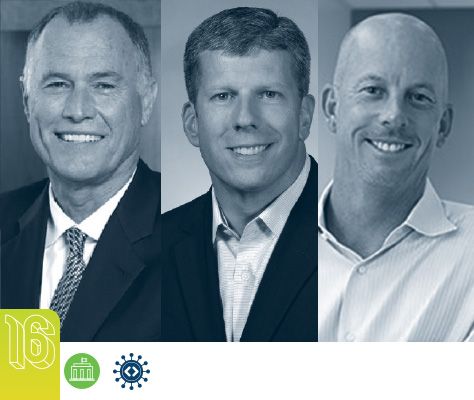 THE DSO OLD-PRO TRIO
THE DSO OLD-PRO TRIO
RICK WORKMAN
Founder and Executive Chairman,
Heartland Dental
Effingham, Illinois
Last year: 12
ROBERT FONTANA
CEO, Aspen Dental
East Syracuse, New York
Last year: 12
STEVE THORNE
Founder and CEO, Pacific Dental Services
Irvine, California
Last year: 12
FROM THE PERSPECTIVE of the 32 Most Influential list, this triumvirate of DSO dandies might as well be joined at the hip, rivals though they are. Their companies are the largest players in the seemingly inexorable expansion of the DSO universe. They’ve been staples of this list since its inception, and each has run his company going back to the 1990s. Their focus throughout: to handle practices’ important but occasionally tedious business functions.
The entire industry has been transformed by what they’ve wrought. Workman founded Heartland Dental in 1997, building it into the U.S.’s largest DSO with a roster of supported practices nearing 1,000. Fontana has been with Aspen Dental since a year later; Aspen assists more than 800 practices across 33 states. Thorne goes back even further, having founded Pacific Dental Services in 1994, and has been instrumental in the formation of the Association of Dental Support Organizations—a support group for the support groups,
if you will, that seeks to consolidate DSO growth nationwide.
All three, still privately held, have big plans for post-pandemic dentistry. At the end of last year, Aspen announced its intention to open as many as 60 new offices and hire 1,000 dental professionals in 2021. Heartland added 50 practices last year, and Pacific reached 600 supported dentists at the end of 2020.
As we noted last year, succession at each company is still an open question for these three. None of them have made any noise about potentially going public—not even Heartland, which is majority-owned by legendary private equity firm Kohlberg Kravis Roberts. In the meantime, then, industry watchers will just have to keep their eye on this trio—as firmly entrenched, seemingly, as they have been since the Clinton presidency.
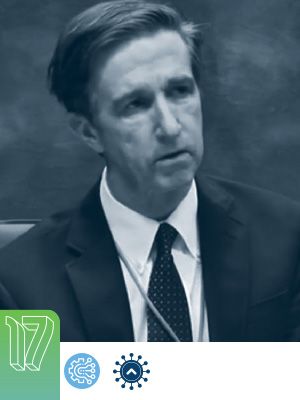 THE MAN IN THE FOXHOLE
THE MAN IN THE FOXHOLE
CASEY HANNAN
Director, Division of Oral Health, the
CDC’s National Center for Chronic Disease Prevention and Health Promotion
Atlanta, Georgia
Last year: 3
DIFFICULT JOBS ABOUNDED in the earliest, most unsettling and chaotic weeks of the pandemic. Imagine, for one, being the person tasked with writing safety protocols for the entire dental industry. Unprecedented times reveal great leaders for who they are, and Casey Hannan, director of the CDC’s Division of Oral Health, rose to meet the challenge. He and his team of experts set out to help dentists and their patients get out of lockdown and back into their practices as quickly, safely and effectively as possible.
A 33-year veteran of public health who has been with the CDC since 1996, Hannan put his core crew of a half-dozen or so to work to determine best practices. Their research produced Infection Prevention and Control Guidance for Dental Settings During the Covid-19 Pandemic, which has been viewed nearly 3 million times on the CDC’s website to date.
Hannan and his team relied on information from microbiologists, virologists and epidemiologists, all part of the CDC’s Emergency Operations Center in Atlanta. “We said, ‘OK, what do we already know about controlling airborne infectious agents in dental settings, and how can we adapt to what we know about the coronavirus?’ ” Hannan says.
Relying on insight from the National Institute of Occupational Safety and Health, Hannan’s crew worked closely with industrial and ventilation engineers to examine the impact of airflow and how it might contribute to viral spread.
It was clear that his efforts would find a receptive audience. “Dental health-care personnel are leaders in providing safe care, regardless of the transmission type,” he observes. He was right: Some 13,000 professionals tuned in last June 3 to the CDC’s first-ever Clinician Outreach and Communication Activity call.
Another thing the pandemic revealed was care-access disparities. Hannan says he sees potential for expanded use of community dental-health workers, as well as tighter integration of dentistry and other medical disciplines. Every year, he notes, “31 million people go to a dental setting who do not see their medical doctor.” Conducting blood-pressure screenings and prediabetes testing during dental visits could make a major contribution, he adds: “It is crucial for dentistry to continue adapting to these new challenges.”
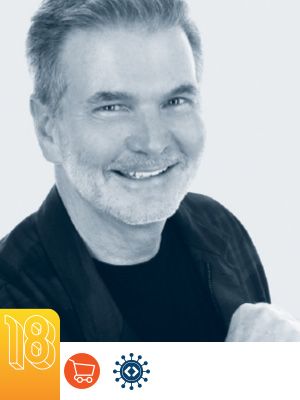 THE SMILE DIRECTOR
THE SMILE DIRECTOR
DAVID KATZMAN
CEO, Smile Direct Club
Nashville, Tennessee
NEW
THE DIRECT-TO-CONSUMER business model (DTC) was beginning to become the hottest trend in retail even before the pandemic, and a year of lockdown and inconvenience has seemingly only further entrenched it. The question remains: Can DTC work for ortho care? David Katzman thinks it can. Smile Direct Club has been a burgeoning player in the teeth-aligner space since 2014, when it was founded by Katzman’s son, Jordan, and his friend Alex Fenkell. SDC grew quickly, fueled by $440 million in venture capital and private equity financing. (Katzman père’s own investment firm, Camelot Venture Group, provided some early funding for the startup as well.)
Steady growth in the ensuing years led to a successful public offering in September 2019, which raised $1.3 billion and valued SDC at nearly $9 billion, making billionaires out of both thirtysomething founders. Its stock tumbled around 40 percent not long after, though, when federal regulators claimed SDC was illegally performing unlicensed dentistry, concerns over the extent to which impressions made at home by patients themselves were accurate and class-action lawsuits from customers.
The stock has recovered as SDC works to combat the inquiries and boost its reputation. (Katzman and his son spent a total of $15.6 million on nearly 2 million SDC shares late last August; the purchases, made through LLCs and a trust controlled by the elder Katzman, were their first pickups of company stock on the open market. At the time, the company said only that the purchases were “further evidence of management’s belief in the long-term value” of SDC.)
Having dropped under $4 per share at the nadir of the market selloff last March, the stock recently closed north of $10 and is up 116 percent in the last 12 months. Revenue in 2020 came in at $657 million, down 12 percent from $750 million in 2019, but Katzman notes that SDC is ramping up marketing spending in 2021 to make that DTC model viable for good. “Our performance throughout [2020] was continued validation of the strength of our business model,” he told investors. “It also demonstrated our ability to deliver on our continued focus of controlled growth and profitability.” Can this grownup in charge keep the model humming? The answer will have big implications for dentistry going forward.
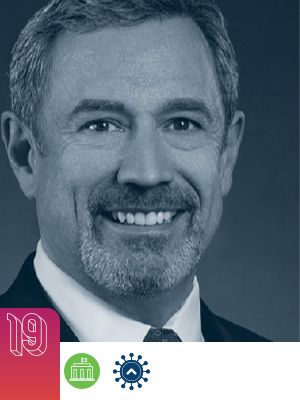 THE GLIDEWELL AIDE-DE-CAMP
THE GLIDEWELL AIDE-DE-CAMP
GREG MINZENMAYER
Chief Operating Officer,
Glidewell Laboratories
Newport Beach, California
Last year: 23
glidewell laboratories has been one of the biggest and most prominent providers of dental lab products and services for more than five decades. With its legendary founder, Jim Glidewell, now 76, at the helm, it became the largest privately owned dental lab in the world, specializing in crowns and bridges, ceramics, implants, prosthetics and more. And the profile of Greg Minzenmayer, Glidewell’s right-hand man for a decade and a half, has only increased as the years have passed.
Minzenmayer joined Glidewell Labs in 2006 as director of business development, bringing with him at the time more than a decade of dental-industry experience. By 2012, he had ascended to his current role as COO, where he’s now responsible for overseeing Glidewell’s daily operations and overall system improvements. Having established its implant business, Minzenmayer then did the same for the daily operations of its implant manufacturing division. He managed the 2010 launch of Glidewell’s enormously popular BruxZir solid zirconia crowns and recently unveiled the Zeramex XT, a two-piece metal-free ceramic implant that provides highly lifelike esthetics for anterior and thin tissues.
We did digital dentistry way back in 2007, and now it’s a 30-person department. The influence of BruxZir changed our lives. It changed the industry.
“In the beginning, digital dentistry was starting in the lab,” Minzenmayer told Benco Dental managing director Chuck Cohen, also the cofounder and publisher of Incisal Edge, on a podcast this January. “We did it way back in 2007. Now it’s a 30-person department, and we process tens of thousands of scans every month through that system. The influence of BruxZir really changed our lives. I think it changed the entire industry.”
More change is afoot: Last year Glidewell built a 25,000-square-foot state-of-the-art research-and-development facility in one of the buildings on its Irvine, California, campus. Heading into 2021, the company—which logged some $210 million in sales last year and employs more than 3,000 people—is working hard to push the limits of digital dentistry. “We’re creating 3D printing presses for 3D printers,” Minzenmayer added in his discussion with Cohen. “We’re also working on a number of processes for printing dentures and working on resins for printing dentures.”
One thing that seems unlikely to change anytime soon is the continued influence of Jim Glidewell himself on the industry. Regardless of the founder’s daily input, though, Minzenmayer’s steady hand on the tiller is reassuring.
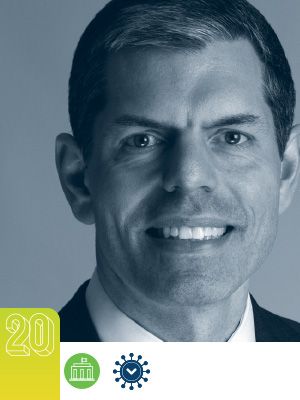 THE SCHEIN STANDOUT
THE SCHEIN STANDOUT
JONATHAN KOCH
Senior Vice President and CEO,
Global Dental Group, Henry Schein
Melville, New York
Last year: One to Watch
AT HENRY SCHEIN, it’s presumably difficult for other executives to step out of the long shadow of Stanley Bergman, who has run the company since 1989. Jonathan Koch, though, is making his best effort, having assumed his current role at the head of Schein’s dental division—responsible for more than half of its annual worldwide sales—in mid-2018, leaving him just enough time to get settled in before the largest global market disruption in decades.
Koch’s appointment was evidently part of Schein’s long-term succession plan; Bergman has been a fixture on this list since its inception, and while he remains at the company, he’s now 70, and Koch is one of the leaders seemingly entrusted to take the reins as needed in the meantime. He was previously an executive at Covance Clinical Development and Commercialization Services, a pharmaceutical and biotech research organization, where he oversaw more than 11,000 employees in 60 countries. He has also spent time at LabCorp, the large diagnostics company. As overseer of all things dental for Schein and interim CEO of Henry Schein One, its practice-management software division, he played a large role in helping steer the ship of state through the turbulent waters of 2020.
Under his leadership, Schein unveiled the Thrive Practice Recovery Program, a suite of resources and guidelines for practitioners returning to the office after lockdown. “We’re dedicated to doing all we can to ensure that our customers emerge strong from this difficult situation,” he said last May. The program focused on safety protocols, best practices for reconnecting with patients and tips for securing financial assistance.
We’re dedicated to doing all we can to ensure that our customers emerge strong from this difficult situation.
During the same period, Schein also debuted TeleDent by MouthWatch, a live, two-way videoconferencing tool for patients and practitioners. The TeleDent portal—one of a number of telehealth initiatives that are certain to outlive the pandemic—is a virtual space for emergency consultations, pre-appointment screenings and post-op visits. Last October, too, Schein acquired the Dentists Supply Company, a move that opened online purchasing of dental supplies and equipment to members of dental associations in all 50 states.
Schein itself, which is listed on the Nasdaq exchange, weathered the spring 2020 market meltdown and by the end of the year had gotten its equity mojo back thanks to its ability to provide PPE and Covid-19-related products to dentists everywhere. (For more about public dental companies’ recovery at the end of last year, see Jeff Johnson, No. 23.)
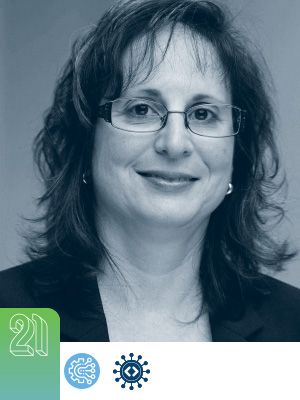 THE ACCESS FACILITATOR
THE ACCESS FACILITATOR
DENISE TERESE-KOCH
Dean, Lincoln Memorial Dental School
Knoxville, Tennessee
NEW
LINCOLN MEMORIAL UNIVERSITY, a heretofore unassuming school in eastern Tennessee, is developing a college of dental medicine with an eye toward welcoming its first class in the fall of 2022. This is no small thing in Appalachia, a notoriously underserved region of the country for dental care. This March, LMU’s president, Clayton Hess, appointed Dr. Denise Terese-Koch (no relation to No. 20 Jonathan Koch, previous page) as the school’s founding dean and applied for accreditation from the Commission on Dental Accreditation and approval from the Southern Association of Colleges and Schools’ Commission on Colleges. Dr. Terese-Koch will be the head of this herculean effort, tasked with developing the incipient school’s DMD program, as well as an associate of science in dental hygiene program, research and community outreach as the autumn of 2022 gets closer.
Access to care (as a number of other entries in this year’s 32 Most Influential list will underscore) is a pressing concern among the wider dental community, and “LMU is at the forefront of developing programs that not only train the next generation of health-care workers but [also] deliver practitioners to medically underserved communities to make those areas stronger,” Dr. Terese-Koch told reporters not long after her appointment. The problem is real: A paper recently published under the auspices of the National Institutes of Health noted that “dental fear” among residents of Appalachia, as well as lack of insurance and limited access to dental practices of any kind nearby, was leading to delayed dental care throughout the region—a factor cited by university administrators as motivation for founding the school and putting Dr. Terese-Koch, who has been a pioneer in expanding access to care, in charge.
She was previously the chair of dental education at South College in Nashville, where she developed and implemented three dental programs. She has been a general dentist since 1992, having received her DDS degree from Loyola University of Chicago School of Dentistry; she also has a bachelor’s in biology from Saint Xavier University in Chicago.
Already, Dr. Terese-Koch has been instrumental in bringing a free dental clinic, Appalachian for Smiles, to the Lincoln Memorial campus, where faculty and students provide care on a sliding scale for residents of Knoxville and the surrounding area. She is also aggressively raising funds for the new school.
It will surely take time for this to gain traction. Yet the pandemic has made it clear that dentistry needs to do a better job of broadening access to the underserved. Keep your eyes on Dr. Terese-Koch and her new academic venture, seeking to do just that for one of the neediest regions of the country.
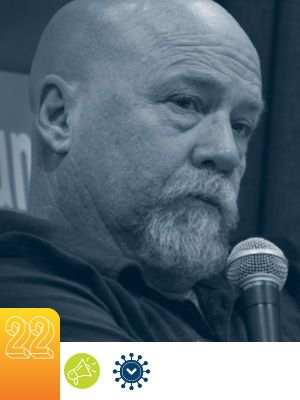 THE ORIGINAL DENTAL MEDIA MOGUL
THE ORIGINAL DENTAL MEDIA MOGUL
HOWARD FARRAN
Founder, Dentaltown.com, Dentaltown magazine
Phoenix, Arizona
Last year: 8
THE EFFERVESCENT DR. FARRAN has been a mainstay on the 32 Most Influential list since it debuted five years ago, hopscotching around our rankings in a manner entirely appropriate for his boisterous personality. As the founder of the industry’s most popular online platform for all things dental, the good doctor, from his Southwestern redoubt, has created strong communities of health-care professionals working to connect dentists to their peers, DSOs and manufacturers alike.
Dr. Farran’s four “channels”—Dentaltown, Orthotown, Hygienetown and Today’s Dental—boast more than a quarter-million subscribers through websites, apps, a magazine (Dentaltown), continuing-education videos, lectures, an immense podcast library and more.
About that renowned podcast: Aptly named Dentistry Uncensored with Howard Farran, it recently marked its 1,500th episode—surely a record for our industry, if not for medical fields overall—and has been downloaded more than 8 million times. Dr. Farran’s guests have included dental professionals from around the world, top-tier specialists, hotly tipped young practitioners not long out of school, chief executives of the largest dental companies and innumerable other persons of interest.
As he plans his episodes and guest lists, Dr. Farran strives to stay topical; a recent episode found him deep in conversation with Dr. Alex Denes, a general dentist licensed in both Minnesota and California, who in March began converting his offices into Covid-19 vaccination clinics to give shots to people in the evening. “I go to Walgreens, and a pharm tech with nine months of training gives a flu shot and saves more lives than all dental offices combined,” Dr. Farran says. “Finally, Tennessee was the first state that passed a law that said, ‘Hell yeah, a dentist can give a flu shot and vaccines.’ ” (This is of a piece, Dr. Farran says, with his general sentiment that dentists should “man up and be a complete doctor.” Consider yourself duly exhorted.)
Challenges to Dr. Farran’s longstanding hegemony abound, of course: They come in all directions, from the proliferation of dental programs available online and via social media. Of late, to help keep his place in the industry media galaxy secure, he has been expanding his own social media following; he now counts some 300,000 Facebook followers, 25,000 on Twitter and 35,000 on LinkedIn. Dentaltown might no longer be the only game in the, er, dental town—but if Dr. Farran can consolidate his head start (and we feel confident asserting that he’ll be able to), you’ll likely be seeing him on future 32 Most Influential lists for years to come.
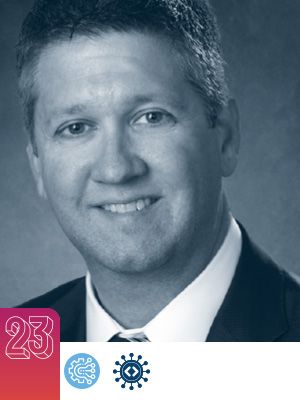 THE MARKET OBSERVER
THE MARKET OBSERVER
JEFF JOHNSON
Senior Research Analyst, Medical Technology, Robert W. Baird & Company
Milwaukee, Wisconsin
Last year: 28
LAST YEAR, as baffled as anyone by the onset of the pandemic and what it might mean for dentistry’s top companies, we tapped Jeff Johnson for his insights into what might lie ahead. The piece he produced, “Brighter Days Ahead?” (Summer 2020), used surveys of dentists, market data and lessons from the Great Recession a decade prior to take a snapshot of the state of dentistry at a difficult moment. If we’re to assume that his titular question wasn’t simply rhetorical, we can now answer it, thankfully, in the affirmative.
For dentists in the U.S. (to say nothing of other professions), the worst of the pandemic occurred from March through May 2020, when forced office closures stalled work and overall patient volumes plummeted an astounding 80 percent or more. Johnson and his team created projections for the second and third quarters of the year based on those initial numbers; thankfully, those models made assumptions far gloomier than was strictly necessary. Across the country, practices started reopening in early May, and patient volumes rebounded to 75 percent capacity within months. “It was a remarkable recovery relative to what we anticipated,” Johnson says. “According to our data and the ADA’s data, people are more comfortable going into dental offices [than] movie theaters or airplanes. So the original perception we had was inaccurate.”
Though patient intake might not rise to pre-Covid levels for all practices this year, higher-intensity casework could help close the revenue gap. Some people are returning for more complex care they put off last year, and in addition to increases in discretionary income, Johnson attributes a boost in complex dental work to a surprising factor: the “Zoom effect,” in which “a lot
of people were going in to get [dental] work done because they started staring at their faces on Zoom every day,” Johnson says, noting that also helps explain Align Technology’s success in 2020: The manufacturer of Invisalign (see Joseph Hogan, No. 1) saw fourth-quarter revenue increase nearly 30 percent over a year earlier. “Aesthetic companies have also had crazy high volumes,” Johnson adds. “So much higher than we would’ve expected in this environment.”
Henry Schein (see Jonathan Koch, No. 20) and Patterson Dental (see Eric Shirley, No. 26) also grew year-over-year over the last quarters of 2020, primarily due to their ability to distribute personal protective equipment to dentists and others who needed it. In 2019, Johnson notes, Schein sold $400 million worth of PPE but more than tripled that figure in 2020. Dentsply Sirona and Envista saw revenue rebound in the last quarter of 2020, as a shift in demand to higher-value dental products helped offset the 15 to 20 percent decline in patient volume practices were experiencing toward the end of the year.
In sum, Johnson observes, it is not to diminish the hardships dentists endured last year to say that things could have been much worse. “I’ve become more optimistic in the past couple months as we see vaccine rates start to accelerate,” he says. “Dental has again shown resilience. As concerned as we get in the heat of negative cycles, every time we seem to come out the other side.”
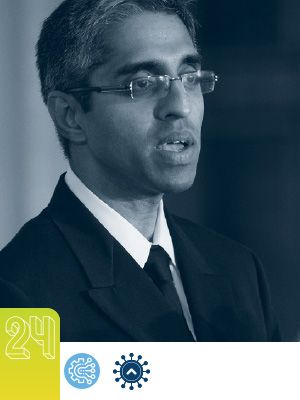 THE “NATION’S DOCTOR”
THE “NATION’S DOCTOR”
VIVEK MURTHY
Surgeon General of the United States
Washington, D.C.
NEW
IT IS NO SECRET to anyone that nothing happens quickly in Washington, and the intrusion of a pandemic—to say nothing of a change in presidential administration and control of Congress—will likely slow D.C.’s ordinarily sluggish pace to a speed not detectable by the Hubble telescope. Which is all a prelude to note that we are still waiting (some of us more patiently than others) for
the update to the Surgeon General’s 2000 report on Americans’ oral health.
Yes, 2000: A tot who was teething when that report was published—by then–Surgeon General David Satcher, whom you might vaguely remember from the furthest mists of time—is now preparing to apply for admission to dental school. (Good luck, kiddo! We’ve had our eyes on you for the last two decades, and we couldn’t be prouder.)
The delay in itself isn’t Dr. Murthy’s doing, of course; he took office only on March 25, having previously co-chaired President-Elect Biden’s Covid-19 advisory board before the inauguration. But with increased public focus on overall health in the wake of the pandemic’s depredations, dentists are eagerly awaiting the official overview from the country’s top doc. (OK, the delay might in part be Dr. Murthy’s doing: He’s the only person in U.S. history to serve as non-acting Surgeon General twice, having also held the position between December 2014 and April 2017 under Presidents Obama and Trump. But we’re willing to cut him a little slack.)
Dr. Murthy, who will turn 44 on July 10, is the very picture of a Renaissance man: Raised in Hawaii, he has degrees from Harvard and Yale and is a published author. Last April, with exquisite timing, he released a meditation on the effect of solitude on human beings, a book entitled Together: The Healing Power of Human Connection in a Sometimes Lonely World.
He has also founded a number of public-health organizations over the years to help combat HIV/AIDS, promote better health in rural areas worldwide and expand access to affordable care in the United States. His office’s new report on oral health, whenever it ultimately arrives, promises, according to Dr. Murthy’s spokespeople, to prioritize “the critical nature of poor oral health as a public health issue; the need to increase awareness of the importance of oral health to overall health and well-being; and the promise of science to transform the oral health of the nation.” It’ll be published in conjunction with the National Institute of Dental and Craniofacial Research (see Dr. Rena D’Souza, No. 3).
As for when it will get here, Dr. Murthy’s representatives are vague, saying only that his office and Dr. D’Souza’s NIDCR “are committed to publishing an update to the 2000 report.” Let’s hope our apocryphal teething tot hasn’t retired from his stellar career in dentistry before it finally sees the light of day.
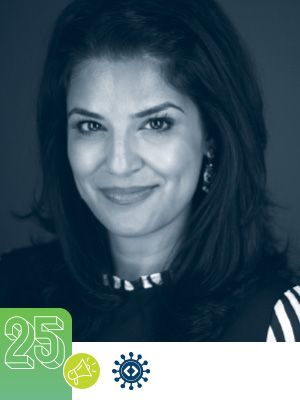 THE CLINICIAN AND CRITIC
THE CLINICIAN AND CRITIC
SABIHA BUNEK
CEO and Editor in Chief,
Dental Advisor
Ann Arbor, Michigan
NEW
WE DON’T KEEP official tabs on such things, but it’s probably a safe bet that Dr. Sabiha Bunek over the years has appeared in the pages of Incisal Edge more than any dentist on the planet. (How does she handle the intrusive paparazzi, we wonder?) Her first appearance came way back in 2013, when she was a member of that year’s 40 Under 40. She has also won a Lucy Hobbs Clinical Expertise Award (2018) and a Best Repurpose practice-design award (2019). Small wonder, then, that she now graces this even more prestigious list.
“Something of an overachiever,” we’ve previously called her, and we certainly stand by that characterization: The Michigan native, University of Michigan graduate and passionate Wolverines sports fan got her start as a technical writer for Dental Advisor before ascending to the top editing job there in 2012 and becoming CEO of the company in 2015. As overseer of Advisor’s editorial board, Dr. Bunek, 42, is instrumental in making decisions about dental products, research and recommendations before they’re published in the 38-year-old journal.
“The editorial board meetings almost feel like a study club, full of critical thinkers and clinicians,” Dr. Bunek tells us. “To some extent, we serve as a filter or quality-control body, because we’re holding people accountable by looking at products before they go into a patient’s mouth and giving feedback on what’s needed or if it’s even fit to go to market—almost like a Consumer Reports for dental products and materials.”
We did studies on aerosols, tested masks and other PPE and were able to make recommendations to dentists about how best to reopen safely when shutdowns ended.
Since its inception in the early 1980s, Dental Advisor has been an authoritative voice of unbiased product research. It now counts 75,000 subscribers, which leads to incalculable real-world influence considering its readership. During the pandemic, its responsibility to dentists only increased. “We’ve done a lot in our biomaterials lab, but during Covid—when research and development were put on hold—we were able to revive our microbiology research laboratory,” Dr. Bunek says. “We performed studies on aerosols, tested masks and other PPE
and were able to make recommendations to dentists about how best to reopen safely when shutdowns ended.”
Her role with the publication also naturally informs the operation of her solo practice, Bunek Dental Studio—whose motto is “Dentistry Done Differently”—which she opened in Ann Arbor (directly across the street from the “Big House,” the Wolverines’ 107,000-capacity home football stadium) three years ago.
“Dental Advisor feeds that research part of my brain of needing to understand the how and why,” she says. “Dentistry isn’t one-size-fits-all, and attention to detail and education is really important and goes hand-in-hand with what I do at Dental Advisor. I’m a better dentist because I get to pick the best products for my patients.”
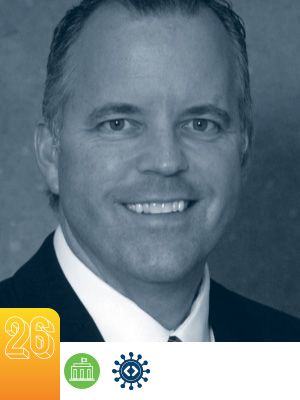 THE PATTERSON REJUVENATOR
THE PATTERSON REJUVENATOR
ERIC SHIRLEY
President, Patterson Dental
St. Paul, Minnesota
NEW
ERIC SHIRLEY ASSUMED his role as president of Patterson Dental in 2019 in the wake of years of both its stock price and its sales trending downward. Now, thanks to a solid sales team and Shirley’s tool kit of previous experience as chief commercial officer at Midmark, where he spent 15 years in total, Patterson’s dental division (it also has a robust animal-health operation) has stabilized.
It’s an old tale in the world of business: An infusion of new blood is sometimes necessary to restore the patient to a modicum of good health. Sounds simple—but it’s fiendishly difficult to execute, particularly when it comes to immense, aircraft-carrier-like companies in the mold of Patterson, which was founded in 1878 in Milwaukee during the administration of President Rutherford B. Hayes. (It got into the veterinary-products business in July 2001 when it acquired a company called J.A. Webster.)
Shirley and his team, though, seem to have succeeded admirably in a short time. He’s responsible for driving revenue, marketing and operational efficiency within Patterson’s dental segment, which distributes products including X-ray film, restorative materials, sterilization products, hand instruments and more.
His work seems to be paying off: In the last quarter of 2020, dental sales were up 12 percent year over year—a somewhat counterintuitive result that likely has a lot to do with practices reopening and in need of fresh equipment and services after lockdown. (Its stock is up nearly a third in the last year, though that’s due in part to better performance in its animal-health division.)
Don’t just take our word for it, though: Jeff Johnson (see No. 23), the analyst’s analyst at Robert W. Baird & Company in Milwaukee, speaks highly of the work Shirley and his colleagues have done to stabilize Patterson and position it nicely for the future.
“We believe CEO Mark Walchirk and his team have done a good job over the last couple years of bringing consistency and solid execution back to the company’s dental segment by beefing up the sales force and looking to fill product and services gaps that existed under prior leadership,” Johnson tells Incisal Edge. “There’s no doubt [Patterson] has also benefited from growing
pet-ownership trends during the pandemic, but companion-animal only accounts for about 30 percent of the company’s global revenue, and investors still seem to look first and foremost at the company’s core dental trends. So without the stabilizing dental performance, shares probably would not have been able to more than double off their mid-2019 lows the way they have.”
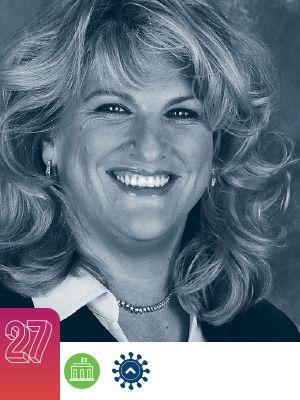 THE FINANCIAL LIFELINE
THE FINANCIAL LIFELINE
BETE JOHNSON
Vice President and General Manager
of Dentistry, CareCredit
Costa Mesa, California
NEW
THE CONGRESSIONAL Budget Office estimates that about 31 million Americans lacked health insurance in 2020. That unfortunate figure is only the point of the spear, too, in a country where millions more lack emergency funds, are underinsured or struggle with existing medical debt. For these people, CareCredit can be a savior.
The company, owned by Synchrony Financial, has been helping finance medical care for patients in need since 1987; Johnson has been with the company for the last two decades. A marketing pro with a sales background, she champions a patient-first approach. “I grew up in a household where my mother was edentulous before age 40, and I saw firsthand how an investment in dentistry gave back her health and lifestyle,” Johnson says. “I’m passionate about the dental profession and the life-changing opportunities it provides.”
More than 11 million people are CareCredit cardholders, and more than 115,000 dental teams nationwide accept the payment option. (It is by a wide margin the dominant player in this space; though the company itself is cagey, estimates of its market share run north of 75 percent.) Patients who prefer to pay in monthly installments can apply for a CareCredit card at the time of their office visit. The merchant offers payment plans with six- to 24-month promotional periods during which the customer will pay no interest; should the balance be fully remitted before the end of the promotional period, they’ll have paid for their treatment in full without a dime of interest having accrued. Most dental procedures—from preventive checkups to implants, braces, headgear and more—can be financed via CareCredit coverage.
According to an October 2020 report by the fintech power player Credit Karma, a group of 20 million Americans hold a collective $45 billion in medical debt—roughly $2,250 per person. “As much as people don’t like talking about money, they do like being in control and having choices,” Johnson told Dentaltown (see Howard Farran, No. 22) in November 2019. “When you let patients know the cost of care and give them all their options, they can choose what’s best for them.”
In 2020, CareCredit integrated with the increasingly popular Open Dental practice-management software system to create a faster, easier, more streamlined process for post-procedure checkout. “Good technology removes friction points and delivers efficiency, speed and consistency,” Johnson says. CareCredit also implemented Custom Link, a contactless payment system in a number of formats including QR Code, late last year. “Custom Link provides patients with access to a contactless experience, so there’s no need for the team to be involved in patients’ sensitive information, explain financing, check IDs, et cetera,” Johnson says. “We’re continually focused on ways we can make it easier for providers, teams and patients to work with us.”
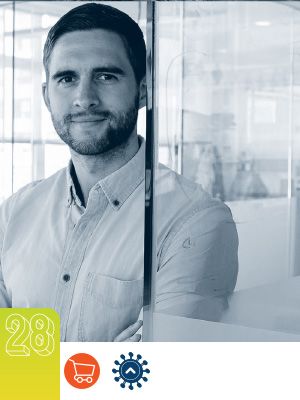 THE DIRECT-TO-CONSUMER DISRUPTER
THE DIRECT-TO-CONSUMER DISRUPTER
SIMON ENEVER
Founder and CEO, Quip
New York, New York
NEW
DURING A REGULAR dental checkup back in 2013, Simon Enever, an industrial designer originally from the U.K., listened to his doctor unspool a soliloquy about how good oral health boils down to two simple tasks: brushing and flossing daily. Well, duh. But why then did so many people face oral-health problems? According to Enever’s dentist, these two simple tasks were being back-burnered by brands selling expensive “gimmicks”—gadgets and doodads that complicated what should be a pair of utterly basic chores.
“The idea to create a brand that put focus back on these basics was born right then,” Enever says. The result, eight years later, is Quip, a direct-to-consumer oral-health company with more than 5 million customers.
Enever discovered that a lack of engagement—for want of a better term—explained many people’s seeming indifference to their oral health. So he and a friend, Bill May, founded Quip in 2014 to provide, Enever says, “a brand, product and service that people actually want to engage with.”
The duo therefore designed an ADA-approved battery-operated toothbrush that uses sonic vibrations to clean. So far, so industry-standard. But Quip used the then-nascent DTC model to help people stop using their brushes for too long, offering a subscription-based service for replacement brushes and paste every three months, as well as oral-health advice and reminders for regular checkups. (Customers can also add their dentist to their online Quip profile—a handy way for the company to expand its marketing efforts as well.)
Quip is privately held and small but growing. It recently debuted its products in Walmart and launched several new ones, including a first-of-its-kind Refillable Floss Pick, a line of oral-care chewing gum and a new Smart Brush.
“We wanted to make a toothbrush that was accessible, desirable and wanted by the 80 percent of people who have never upgraded their toothbrush to an electric one,” Enever told CNN in 2019. “By taking out all the features that didn’t make a big difference and focusing on the ones that did, we could make something much more simple, affordable and, hopefully, enjoyable to use.” The model seems to be working, but the competition
is fierce. Can Quip consolidate its early gains? Stay tuned.
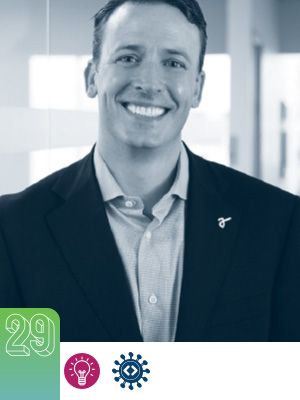 THE LAB WHISPERER
THE LAB WHISPERER
ANTON WOOLF
CEO, Argen
San Diego, California
Last year: 27
ARGEN IS THE WORLD’S largest manufacturer of precious dental alloys, and under CEO Anton Woolf, its mission is substantial but simple: to make dental laboratories more successful. To that end, Argen helps its clients cut costs and turnaround time by manufacturing many of their products for them, including Argen’s own branded clear aligners.
Under Woolf’s leadership, the company has diversified and expanded into a variety of significant strategic businesses, moving into an 80,000-square-foot digital manufacturing center in San Diego with new machines and advanced automation, and investing in its online platform—ensuring that it can now begin fulfilling a new order within three minutes of a customer submitting it over the web. (Perhaps inevitably, just-in-time delivery has now been joined by just-in-time manufacturing—an important outgrowth of the technological revolution of the last few decades.)
Like almost all other businesses, of course, Argen was faced with immense challenges when the pandemic arrived; sales in April 2020 plummeted 90 percent from the same month a year earlier. The company swiftly pivoted, however, to manufacturing 3D-printed nasal swabs and face shields—a move that enabled Argen to retain 100 percent of its employees throughout the worst of the crisis, Woolf says. It also extended the terms on its lab customers’ payment plans, and when practices and other companies began reopening, labs leaned on Argen to make digital crowns and frameworks as they began rehiring furloughed staffers—as close to a virtuous cycle as might have been possible last year.
“We spent 2020 focusing on research and development and increasing our infrastructure,” Woolf says. “And in early 2021, we had the largest sales of zirconia discs and custom abutments in the history of our company.” Argen is positing 50 percent growth in certain key business segments for the whole of this year, and is expanding its manufacturing facility by 35,000 square feet. The overall economy looks set to roar back in 2021 and beyond—and in the dental space, few are as well-positioned as Argen to take advantage.
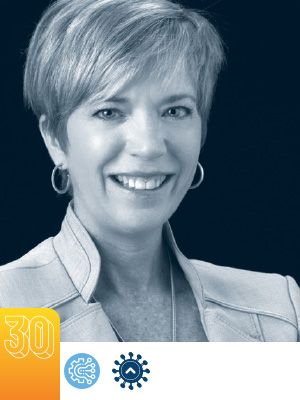 THE SAFETY GURU
THE SAFETY GURU
MICHELLE LEE
Executive Director, Organization for
Safety Asepsis and Prevention
Atlanta, Georgia
Last year: 19
WHEN THE COVID-19 OUTBREAK was officially declared a pandemic last March 11—a day that will live in infamy—the Organization for Safety Asepsis and Prevention was ready. That very day, the 37-year-old membership association completed the final phase of a first-of-its-kind dental infection-control certificate program—a project that, in conjunction with the Dental Assisting National Board and the DALE Foundation, OSAP had been working on for more than five years. Talk about timing.
As of press time, some 1,000 dental professionals have earned the OSAP–DALE Foundation Dental Infection Control Certificate; formal certification will roll out later this year. The importance of OSAP in creating and coordinating infection-control protocols for dental offices is hard to overstate. Under Michelle Lee’s leadership—she has been the head of OSAP since August 2018—the guild of clinicians, educators, consultants, researchers, federal-services employees and industry representatives (its goal: to provide “the Safest Dental Visit”) was poised to comprehensively meet the challenge to protect clinicians and patients around the globe in an unprecedented crisis.
OSAP developed a Covid-19 tool kit of resources and guidelines that it published on its website within about a week. With the help of a grant from the DentaQuest Partnership for Oral Health, it also put together a best-practices checklist—an organic document, free to anyone, of regulations and protocols for reopening. Finally, it published an informational document for patients, available in English and Spanish, detailing what to expect when returning to the dental office for a checkup.
When Lee assumed the leadership mantle nearly three years ago, she focused on reinforcing OSAP’s determination that every dental visit be flawlessly safe. “If we’re ever able to achieve this vision, more dental professionals need to know who we are,” Lee says. “They need to be aware of our great resources and educational opportunities.” During the pandemic, Lee dived headlong into active outreach, doing anything she could to create a two-way conversation—including being contracted by the CDC to host “listening sessions”—between OSAP and industry groups. “We could have easily just created our own webinars and events,” she adds, and indeed it did. “But we knew that if we worked with other associations we’d have greater reach.” The listening sessions were ultimately attended by more than 20 dental associations—helping give the profession an information baseline in the crucial, hectic, unsettling early weeks of the coronavirus outbreak.
 THE SAVVY MILLENNIALS
THE SAVVY MILLENNIALS
KENDALL JENNER
Cofounder, Moon Oral Care; Co-Developer,
the Kendall Jenner Teeth Whitening Pen
Calabasas, California
NEW
SHAUN NEFF
Cofounder, Moon Oral Care; Co-Developer,
the Kendall Jenner Teeth Whitening Pen
Los Angeles, California
NEW
FOR BETTER OR WORSE, Kendall Jenner needs no introduction. If the name Shaun Neff rings a bell, though, it’s not necessarily just because you spend too much time reading TMZ. (No judgments here, we swear.) Neff, in his early 40s, is the cofounder of Moon Oral Care and the Kendall Jenner Teeth Whitening Pen and has been around the entrepreneurial block a time or two. He’s the founder of Neff Headwear, which he founded in 2002 while studying marketing at Brigham Young University. Since its inception, Neff Headwear—whose slogan is “#ForeverFun,” hashtag and all—has become beloved in skate culture. He sold the highly profitable business to apparel company Mad Engine in 2017 and was named chief creative officer of the company.
His venture into oral health was a little more polished. In an interview with Glossy.com in 2019, the year he cofounded Moon Oral Care, Neff described strolling through a grocery store, looking at everything, as was his wont, through a marketing prism. “The oral-care aisle was the ugliest,” he said. “These big blue-and-green bottles, the same toothpaste I’ve seen since
I was a kid. I thought, ‘Wow, what an opportunity to come in there and make a product that looks beautiful.’ ”
Accordingly, the aesthetic and ethos of Moon Oral Care are designed to capture the hearts and minds of younger consumers—a proven strength of Neff’s brand-building acumen. Moon’s products—whitening strips, floss, breath mints and much more—are vegan and free of parabens, sodium laureth sulfate and artificial flavors. They come in sleek, genderless black-and-white packaging. Its signature item, the Kendall Jenner Teeth Whitening Pen, was codesigned by the ubiquitous 25-year-old model, entrepreneur and reality-TV star. “Oral care has never been looked at as rad or cool, and Kendall is both of those things,” Neff told Allure. “It was like, let’s work with her and put this thing on the map. When you combine killer product, killer packaging and killer goop inside with someone like her, we’ve got something special.”
The pen, which launched in 2019, had fortuitous timing: Whitening products went gangbusters on social media, particularly TikTok, during the pandemic, and sales of whitening pens are projected to rise substantially in the next five years, according to Transparency Market Research. Given Jenner’s vast influence—she has more than 200 million social media followers—Moon Oral Care’s future would seem to be bright indeed.
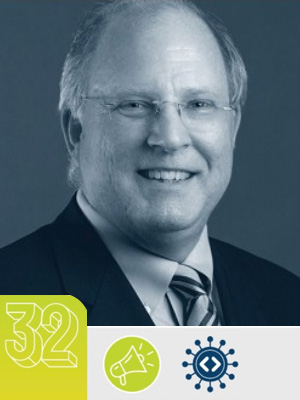 THE LEADER OF LABS
THE LEADER OF LABS
TOM DAULTON
CEO, National Dentex Labs
Cincinnati, Ohio; St. Petersburg, Florida
NEW
WHAT MAY PROVE to be the most significant industry tie-up of 2021 occurred relatively quietly at the end of March and the beginning of April, with the announcement that National Dentex Labs (NDX), the largest dental-lab network by revenue in the U.S., had acquired its smaller competitor Dental Services Group (DSG). Leading the charge of the combined unit, which will operate under the National Dentex Labs name, is NDX chief executive Tom Daulton.
The sought-after goal, of course, is the synergy a well-paired acquisition can bring, both in expertise and economies of scale. NDX, which focuses on dental prosthetics and restorative-dentistry products, boasts nearly three dozen labs across the country, and its pickup of DSG broadens its scope to encompass implants, orthodontics and sleep dentistry. “DSG brings complementary technical expertise, DSO relationships and a variety of options from their full-service laboratory network,” Daulton said when the acquisition was announced, praising his new partner for holding the “same core values” as NDX.
It’s also evidence of the increasing importance in dentistry of private equity investors; NDX’s acquisition of Dental Services Group came just six months after Cerberus Capital Management, a New York–based firm with some $53 billion in assets, took a controlling stake in NDX. Cerberus’s move no doubt indicates that the pressure will be high for a solid return on investment in the coming years.
He keeps his eyes focused on the future in other ways, too: Last September he became one of 15 founding members of the Dental AI Council, which will conduct research on the potential applications of artificial intelligence for dentistry. That’s only one indication of the increasing specialization of the discipline, which means labs will only grow in importance—and complexity—as the industry further develops to encompass technologies like AI. Daulton’s position at the head of the vital partnership with DSG makes him well-positioned to pilot, and profit from, that development.
THE DOCTORS ARE OUT
Where are all the dentist-politicians?
THREE OF THE FOUR previous 32 Most Influential lists have included at least one of the dentists with a Congressional-service hobby. Last year, we ranked at No. 5 the entire cohort of dentist-Congressmen, all
of them Republicans: Brian Babin (Texas), Drew Ferguson (Georgia), Paul Gosar (Arizona), Mike Simpson (Idaho) and
Jeff Van Drew (New Jersey).
There are no dentists in the evenly divided Senate, and given Democrats’ current narrow control of the House, this quintet is likely to see its ambitions shrivel for the time being. Their dentally minded work has generally taken the (so far futile) form of introducing bills that would provide debt relief to dental students. The most prominent such initiative, the Resident Education Deferred Interest Act—proposed by Reps. Babin, Gosar and three others in March 2019—would enable dental students to defer their loans interest-free during a residency. It languishes somewhere deep in the bowels of Capitol Hill.
Democrats currently enjoy unified control of Congress and the White House, but another election is only 18 months away. Look for some or all of these five to return to this list in 2022.
One additional complicating factor: Rep. Gosar seems to have cast his lot, for now at least, with the “insurrectionist” wing of the GOP; in mid-April, he produced a 30-page official response to a House Democrat who had called for an ethics investigation, claiming that Rep. Gosar had helped incite the Capitol riot on January 6. “Know this,” Gosar’s report said. “I have never instigated violence. I have no criminal record of any type.”
Well, November 2022 is just around the bend. Don’t we all deserve a break from the partisan fray for just a moment? Indeed we do. Doctors, you’ve been booted from our list for the time being. Perhaps we’ll meet again. Stay tuned, gentlemen.



